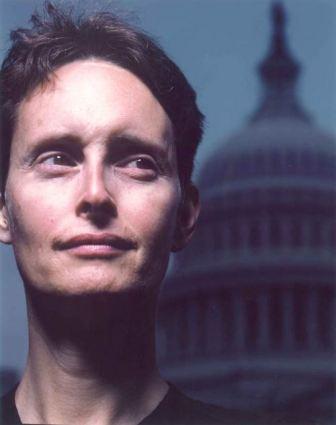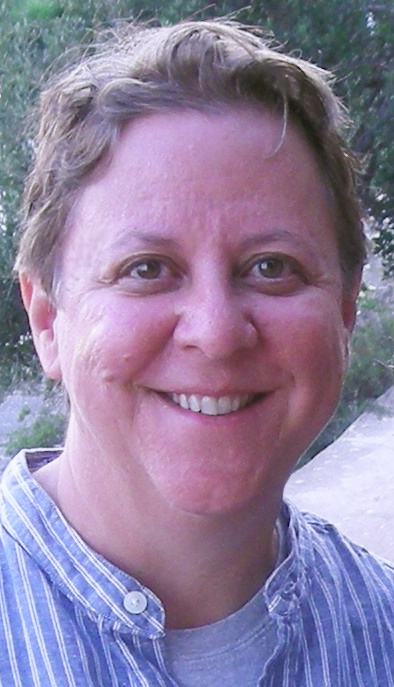Serendip is an independent site partnering with faculty at multiple colleges and universities around the world. Happy exploring!
Notes Towards Week 3 (Sept. 13): Enforcing Normalcy, Entangling Difference
To begin--> highlighting the (over?) abundance of this course:
Cris Williamson, "Waterfall," The Changer and the Changed

Portrait of Eli by Riva Lehrer: "The body is the first story...assumptions/ pour forth...."
I. Anne: Coursekeeping
continuing to get acquainted...
get up, introduce yourself to someone you don't know,
and--following Eli Clare-- tell them where
your "home" is, where you most "belong";
Inspired by Stephen Dedalus, via essietee:
"We are all part of something larger than ourselves,
larger than the confines" of [identity categories...]
then discuss: what "multi-issue politics
might make [your] home possible?"
sign in (each week: we do expect you to
come--don't miss more than one class)
today's snacks by sel209 and Gavi (thanks!);
next week by lwacker and charlie
(if/when you need to check, you can find the sign-up sheet
on-line on the home page, where you can also now our class notes
(if you need to check details, or have missed class...); we have
also assigned you into writing groups for your first two papers
--all HC students will work w/ Anne; all BMC student w/ Kaye
(and then we'll switch!)
Next week, you'll need to schedule a conference w/ your writing instructor,
to discuss your first paper, due Oct. 2, on en/abling intra-actions of gender, sexuality,
disability, and/or ....?? -- come prepared w/ some ideas you're not yet too attached to!
(we'll bring sign-up sheets next Tuesday....)
Anytime between now and next Sunday @ 8 p.m., go to our
web forum again and reflect on/diffract our conversation so far
For next week, we'll continue this first "act" of the course,
on Dis/Ability and Intra-Action, by reading and discussing 3 web essays:
Ray McDermott and Hervé Varenne's 1995
classic anthro-of-ed essay, Culture as Disability.
a follow-up 2003 essay by Hervé Varenne, Extra burdens
in the search for new openings: on the inevitability of cultural disabilities
& Paul Grobstein's 2010 commentary/elaboration: Cultures of Ability
--all these are on-line, on Serendip (rather than our password protected file)
we will also go on discussing Eli Clare's work, so bring that book back again...
II. Looking back, @ Wilchins' and Barad's work....

Your postings
most remarkable, but buried by more recent posts? so mebbe you didn't see it?
(pay-off for having these conversations "out of the closet of Blackboard and Moodle"--
we're not talking about people/their work behind their backs, but in front of their faces/screens!):
Riki Wilchens' response to Ann/Shlomo's description of her "obvious slanted perspective,
not very balanced account": "I agree. The author *is* prejudiced in her views."
many of you continued to mull over our (unfinished!) conversation from last week,
and a number of you found links between this and last week's readings:
KimK : that Clare must betray part or all of his rural or queer identity … is no different than the gay men who live outwardly straight lives in order to maintain their acceptance in their religious community.
alice.in.wonderland: Living with multiple opposed/competing, yet still simultaneously "true" identities is the crux what the homosexual evangelicals were struggling with. It's also how Clare describes a lot of his experiences ....
some of you also began theorizing more broadly-->
KatieRandall: Thinking about …. “slits” of the gender binary… later, I was struck by a huge misunderstanding in my approach to the question. I think the foundation of not “doing” a gender has nothing at all to do with individual actions, and everything to do with observation. To not “do” a gender, I don't have to change my way of behaving…To not do gender, and to allow others to not do gender, I have to change my way of seeing …. The issue of gender is fundamentally an issue of the observer.
there was also a great thread (leamirella --> aybala50 -->Gavi): thinking about a "boxless" world is an… almost impossible exercise…We are trained and retrained to categorize, and the boxes we create are often narrow and cruel and trap certain individuals while excluding others….I find it very difficult to imagine a world where individuals could interact on a meaningful level without some deep, roomy boxes at their disposals….On what grounds would connections be formed, and how would they grow roots and spread?… I think a boxless world could be a sad place, with minimal social currency and empathy....
III. Kaye: picking up on this, via Barad's second key term: entanglement

preface: "this book is about entanglements. To be entangled is not simply to be intertwined with another, as in the joining of separate entitites, but to lack an independent, self-contained existence. Existence is not an individual affair. Individuals do not preexist their interactions; rather, individuals emerge through and as part of their entangled intra-relating."
Dr Quantum--entanglement
p. 90: "as Haraway suggests, a diffractive methodology is a critical practice for making a difference in the world. It is a commitment to understanding which differences matter, how they matter, and for whom. It is a critical practice of engagement, not a distance-learning practice of reflecting from afar."---
p. 91: "...the point is not merely that knowledge practices have material consequences but that practices of knowing are specific material engagements that participate in (re)configuring the world.
p. 93: "...my method is to engage aspects of each (disciplinary practice) in dynamic relationality to the other, being attentive to the iterative production of boundaries, the material-discursive nature of boundary-drawing practices, the constitutive exclusions that are enacted, and questions of accountability and responsibility for the reconfigurings of which we are a part."
IV. Now: applying the theory!
Let's diffract Karen Barad and Eli Clare ....
Kaye's examples of entanglement/diffraction:
"...woven through and around the private and intimate is always the public and political." (149)
Combahee River Collective, 1977: ...(W)e are actively committed to struggling against racial, sexual, heterosexual, and class oppression, and see as our particular task the development of integrated analysis and practice based upon the fact that the major systems of oppression are interlocking. The synthesis of these oppressions creates the conditions of our lives." (xi)
[there are many more where these came from!]
You and your partner find another pair; return to Exile and Pride
and pull out examples of entanglement/diffraction.
So: let's see what the pay-offs are for this methodology. For me, it was in Clare's reference to the feminist sex wars (debates among feminist activists about the use of sexualized images of women in advertising, movies, pornography, erotica): "This analysis has led to much powerful feminist activism in the past 25 years against rape and child abuse, against pornography and other media portrayals of women. But when taken to its extreme--sometimes in the form of legislation--it has also led to pro-censorship stands, bizarre agreements with the right wing, and narrow, dogmatic view about sex and sexual imagery. (and here I read about nodes and anti-nodes) It succeeded in bringing to the foreground what is degrading, humiliating, and dangerous about sexual objectification, but failed to understand the complicated realtionship between the self as subject and the self as object. It spoke eloquently about the damage that can be caused by pornographic sexual representation but failed to embrace the need for pleasure. It named certain sexual behaviors as oppressive, but failed to take into account the multi-layered reality of erotic power." (132)
What pay-offs did you find? What diffractions?
As finale: "Gender reaches into disability; disability wraps around class; class strains against abuse; abuse snarls into sexuality; sexuality folds on top of race...everything finally piling into a single human body." (143)
V. Breaking, stretching, snacking....
IV. Anne: For today, we asked you to read
Exile and Pride: Disability, Queerness, and Liberation
along with a webpage, Cripping Sex and Gender, which archives a
discussion panel @ last year's Disability Studies Conference --
and to think about/reflect on/diffract the
"intra-action" of gender studies and disability studies:
what's happening to each field of study in this exchange,
what Eli calls "multi-issue thinking and organizing"?
count off to 12, pair up to discuss:
what do you see, when you look @ this image? how do you feel?
what about this one? what do you notice? how do you react?
can you "diffract" your experience through the lens of disability studies?
François-André Vincent, Zeuxis Choosing His Models for the Image of Helen from Among the Girls of Croton
now: how about Josh Blue's Stand-Up Comedy?
share with the larger group something you learned from your partner's reaction/reflection/diffraction
diffracting this conversation again, w/ the help of Eli Clare:
handicapped, disabled,cripple, gimp, retard, differently abled, physically challenged, freak....
"Queer belongs to me. So does cripple for many of the same reasons. Queer and cripple are cousins: words to shock, words to infuse with pride and self-love, words to resist internalized hatred, words to help forge a politics. They have been gladly chosen... Freak is another story. Unlike queer and crip, it has not been widely embraced in my communities. For me freak has a hurtful, scary edge; it takes queer and cripple one step too far..." (p. 84)
What and who defines "one step too far"?Who draws those lines?
What can you do/say if you (or someone else) steps over those lines?
see also:
Eli Clare, East Oakland
Selected Bibliography of Disability Studies Resources
I got my education into Disability Studies from Kristin Lindgren @ HC;
the panel presentation you read about showcases a range of possibilities that this
field intersecting/intra-acting w/ gender studies opens up; I will highlight two:
1) the analogy of "queering = cripping":
"... to resist the negative interpellations of being queer or crippled (not to mention queer and crippled), members of both groups have developed a wry critique of hegemonic norms. In queer communities, the application of this critique has been given its own verb: to queer. Queering describes the practices of putting a spin on mainstream representations to reveal latent queer subtexts; of appropriating a representation for one's own purposes, forcing it to signify differently; or of deconstructing a representation's heterosexism. Similarly, some disabled people practice "cripping." Cripping spins mainstream representations or practices to reveal able-bodied assumptions and exclusionary effects. Both queering and cripping expose the arbitrary delineation between normal and defective and the negative social ramifications of attempts to homogenize humanity, and both disarm what is painful with wicked humor, including camp." Carrie Sandahl, "Queering The Crip Or Cripping The Queer?:Intersections of Queer and Crip Identities in Solo Autobiographical Performance." GLQ: A Journal of Lesbian and Gay Studies 9.1-2 (2003) 25-56.
2) the way this enables a enlarged challenge to the "hegemony of normalcy" :
"the 'problem' is not the person with disabilities; the problem is the way that normalcy is constructed to create the 'problem' of the disabled person" (p. 24).
"The concept of a norm, unlike that of an ideal, implies that the majority of the population must or should somehow be part of the norm. The norm pins down that majority of the population that falls under the arch of the standard bell-shaped curve .... Any bell curve will always have at its extremities those characterisitcs that deviate from the norm. So, with the concept of the norm comes the concept of deviations or extremes. When we think of bodies, in a society where the concept of the norm is operative, then people with disabilities will be thought of as deviants" (p. 29)
"One of the tasks for a developing consciousness of disability issues is the attempt ... to reverse the hegemony of the normal and to institute alternative ways of thinking about the abnormal" (p. 49).
--Lennard Davis, "Constructing Normalcy: The Bell Curve, the Novel, and the Invention of the Disabled Body in the Nineteenth Century." Enforcing Normalcy: Disability, Deafness and the Body.
How is a norm useful?
How is it destructive?
How much does a notion of what is normal underlie
our reactions to/judgments of others/ourselves?
Do you represent a norm? (Have you ever felt that you did?)
Look around the room: where is the norm? Who represents it?
(in gender, sexual orientation, race, class, religion, ability....?)
How much does normalcy enter into the
constructions of our disciplines and curricula?
in science: survival of the fittest
in social science: statistical norms
in humanities: normalized forms (genres?)
Abnormal Psych
Sociology of Deviance
Others?
5.Mathematics .


